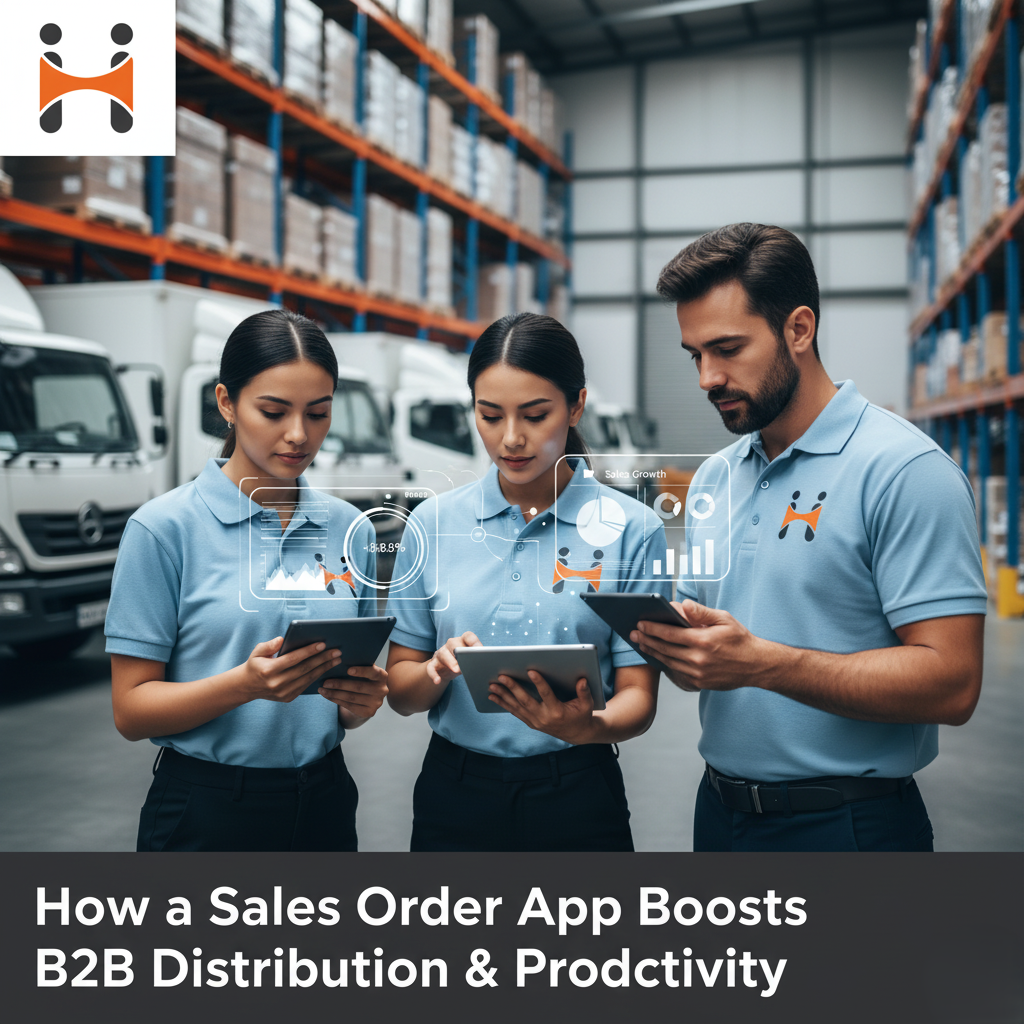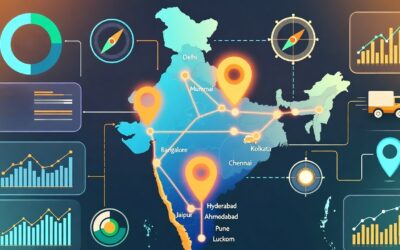How a Sales Order App Streamlines B2B Distribution and Boosts Field Productivity

Distribution in B2B has become more complex. Field sales teams manage many orders, changing routes, inventory shifts, and demanding customers while trying to meet targets and report accurately.
Many companies still rely on manual order entry or spreadsheets. This slows down operations, causes missed sales, and frustrates teams. A sales order app or order taking application helps manage orders efficiently and track field activity in real time.
It improves the place and distribution strategy by giving visibility into outlet coverage and delivery performance. Insights from the app can support a B2B loyalty platform and help design marketing strategies for retail stores. By knowing what sells, how frequently, and where, businesses can plan better and optimize the retail mix comprises of products to meet customer demand.
Using a structured tool like this ensures your Happisales plan in sales is executed smoothly, giving managers and reps control over the entire process.
What Exactly Is a Sales Order App?
A sales order app is a tool that helps field sales teams record and track orders in real time from their phones.
- It goes beyond basic data entry. Reps can enter orders instantly with accurate product and pricing information. The app works offline, saving data locally and syncing automatically when connectivity returns.
- The app connects with inventory, CRM, and accounting systems to give a complete view of operations. Location tracking lets managers monitor routes and field visits in real time.
- This makes orders more accurate and gives both sales and distribution teams a clear picture of what is happening in the field.
Why B2B Companies Need Order Automation?
Traditional order processes rely heavily on manual work between sales reps, distributors, and back-office teams. Each step can cause delays and mistakes.
A sales order app and order taking application automate these tasks. Reps can log customer interactions, record orders, and collect payments efficiently. Supervisors can track visits, order values, and routes in real time, improving the place and distribution strategy.
Integrating a B2B loyalty platform becomes easier with accurate order and visit data, helping reward distributors or high-performing reps. Field sales automation increases speed and visibility across the supply chain, making sure products reach the right customers on time.
How a Sales Order App Improves Place and Distribution Strategy?
Place in marketing means how well your product reaches customers. For B2B companies, this involves managing distributors, retailers, and field teams efficiently.
A sales order app helps by mapping outlet coverage so you know which stores or territories get regular visits. It optimizes routes so reps travel efficiently between meetings and outlets. It tracks field execution to see which visits were completed, skipped, or delayed. It also reduces fulfilment gaps by aligning orders with available stock.
The result is a faster, more reliable distribution flow with fewer missed opportunities, better coverage, and satisfied customers.
Boost Field Team Productivity with Field Sales Automation
When field executives have the right tools, their productivity and confidence improve.
A well-designed sales order app tracks activity and makes daily tasks easier. Reps can see their tasks, customer details, and sales targets. They can log orders, payments, and follow-ups quickly. Push notifications remind them of pending visits or overdue collections. GPS-based attendance keeps them accountable without micromanagement.
Managers get real-time visibility of team performance. They can spot who needs help, who is excelling, and where to focus coaching. Teams using automation tools usually process orders 30 to 40 percent faster and improve daily productivity significantly.
Using a Sales Order App to Support a B2B Loyalty Platform
A sales order app is not just for transactions. It helps build engagement and trust.
Every order and visit logged provides data on customer buying patterns, frequency, and value. This data can support a B2B loyalty platform that rewards consistent buyers, top distributors, or high-performing field reps.
Managers can set incentives based on targets. Teams can track their progress in real time. Organizations can celebrate achievements openly.
When the app serves as both a sales order system and a motivation platform, it helps build stronger, long-term relationships inside and outside the organization.
Offline Features in a Sales Order App for Field Efficiency
- Field executives often work in areas with limited network access such as rural outlets, remote warehouses, or dense city markets.
- Offline capability lets your team log orders even when disconnected. They can save data locally and sync it later. Route planning and visit tracking continue without interruption.
This always-on design keeps productivity steady no matter where your team operates.
Location Tracking in Field Sales Automation for Better Accountability
Location tracking is an important feature of any field automation platform. When used responsibly, it builds transparency and trust.
With permission-based tracking, businesses can verify store visits without constant check-ins. They can analyze travel efficiency and optimize future routes. Teams can ensure compliance with safety and coverage requirements.
Clear communication is key. Field teams should know how and why location data is used to improve efficiency, streamline reporting, and enhance customer service. At Happisales, transparent tracking reduces disputes and naturally builds accountability because reps see that the data helps them, not works against them.
Using Analytics in a Sales Order App to Drive Insights
All the data collected from orders, visits, locations, and customer feedback becomes useful insight through analytics dashboards.
Businesses can monitor total orders and value by rep or region. They can track most-sold products and emerging demand patterns. Visit frequency per customer, conversion rates per outlet or territory, and achievement versus target ratios are all visible.
These insights help sales managers spot growth opportunities and create strategies based on real data.
Simple Sales Order App Workflows Improve Adoption and Productivity
When introducing automation to a field team, complexity reduces adoption.
In one deployment with over 200 sales reps, the initial app required seven steps to complete an order. Reps logged fewer entries. After simplifying the workflow to three screens, adoption rose to nearly 90 percent within a month.
Digital tools should make work easier, not harder. Reps adopt technology when it saves time and smooths their day. This drives productivity and consistent reporting.
How to Get the Most Out of Your Sales Order App?
When picking a solution, focus on the key points.
Choose an app that works offline and supports multiple languages if your team operates in different regions. Make sure it connects with your CRM or ERP to avoid duplicate work. Use reporting tools that match your KPIs. Train your field teams before rollout since adoption depends more on culture than technology. Check that the vendor provides real-time support and regular updates.
The app should fit naturally into your sales process and not feel like an extra system to manage.
Measuring Impact: KPIs That Matter
Once the app is in use, track performance with clear metrics. Watch order accuracy, average time per order, coverage efficiency for outlets visited versus planned, average revenue per rep, sales cycle time, and customer retention.
When these metrics improve, it shows your investment in automation is paying off.
Creating a Culture of Recognition and Growth
A strong sales culture depends on recognition, feedback, and transparency.
Order apps can show performance dashboards, highlight achievements, and suggest improvements using machine learning. Managers do not need to track recognition manually because the system handles it automatically. Over time, this builds a motivated workforce that values accuracy and accountability.
What’s Next
Automated field sales management is now a must. Companies that wait for end-of-day updates fall behind those that track activity in real time.
To improve visibility, accuracy, and performance across your sales team, it is time to take action.
Happisales lets you automate sales, collection, and order management workflows. You can track field activity offline, monitor team performance and location in real time, and get ML-based insights for continuous improvement.
Start with a 14-day free trial with no credit card. See how simple it is to boost visibility and productivity and experience the results for yourself.
Frequently Asked Questions
1. What sales tools help field sales teams?
Use a sales order app or order taking application with CRM and analytics tools. They track orders, reduce errors, and support a B2B loyalty platform by rewarding repeat buyers and top distributors.
2. How does CRM improve customer satisfaction?
CRM tracks orders, visits, and payments. It helps teams deliver on time, understand how the retail mix comprises of products, and improve marketing strategies for retail stores.
3. What are the benefits of CRM and automation in B2B sales?
CRM and automation simplify order management, track field activity, and generate reports. They support the Happisales plan in sales and strengthen B2B relationships.
4. How can a sales order app boost productivity and distribution?
Reps can log orders in real time, plan routes, and work offline. Managers track locations and progress. The app improves place and distribution strategy, reduces delays, and keeps products reaching the right outlets.
5. Which KPIs show the impact of field sales automation?
Track order accuracy, time per order, outlet coverage, revenue per rep, sales cycle, and retention. These metrics show how automation and sales order apps improve efficiency, support B2B loyalty, and optimize the retail mix.

